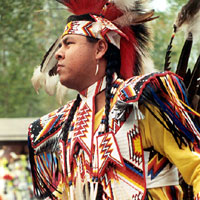 |

來自奧克拉荷馬州阿帕契的卡曼其人(Comanche):蓋瑞(Gary
Tomahsah),他正準備參加男士傳統舞蹈競賽,1999年的祈禱儀式

|
 |
|
 |
淚水小徑祈禱儀式
地方性遺產
1828年時,在喬治亞州的切羅基族印地安人的屬地上發現了黃金。這也讓那些開始向南部及西部領土邁進的白人,更加覬覦這塊土地。1838-1839年的秋季及冬季,15,000名切羅基人被迫離開他們的祖傳土地,將這片土地讓給那些移民。他們被迫搬到1,200哩外的地區,即現在的奧克拉荷馬州,約有4,000名切羅基人死於旅途中。
因為他們在這條路上所承受的諸多困境,所以這條他們行經的路徑又名「淚水小徑」(The
Trail of Tears)或「他們哭泣的小徑」(The
Trail Where They Cried)。肯塔基州的霍普金斯維爾(Hopkinsville)是這趟旅程中的休息站。1993年時,霍普金斯維爾境內的淚水小徑紀念公園正式對外開放,這座公園主要是為了頌揚美國的原住民:切羅基人及其他的印地安人。
每年九月,公園內會舉辦一場祈禱儀式。這是一場美國原住民,以及所有喜愛或想要得知更多美國原住民文化及傳統的聚會。身著原住民服飾的舞蹈、歌唱、說故事、及工藝展覽都是慶典中的一部分。數以千計的人,會自國內各地前來參加此一慶典。
In 1828, gold was discovered on land belonging to the Cherokee Indians in Georgia. This made the land even more desirable to white settlers who had begun expanding south and westward. In the fall and winter of 1838-1839, 15,000 Cherokees were forced out of their ancestral lands to make room for those settlers. They were made to move to what is now Oklahoma, a journey of 1,200 miles. About 4,000 Cherokees died on the way.
The route that they followed is known as "The Trail of Tears" or "The Trail Where They Cried" because of how much they suffered on the way. Hopkinsville, Kentucky, was a stopping point on that journey. In 1993, the Trail of Tears Commemorative Park opened in Hopkinsville to honor the Cherokees and all Indians, the original inhabitants of America.
Every September, there is a powwow in the park. This is a gathering of Native Americans and those who enjoy or want to learn more about Native American culture and traditions. Dancing in native costume, singing, storytelling, and craft demonstrations are all part of the celebration. Thousands of people come from all over the country to participate.

 1/1 頁
1/1 頁

關於地方性遺產

|





